SO3 Optimization: Effects on Cement and Concrete Properties
VerifiedAdded on 2022/09/17
|30
|8379
|27
Report
AI Summary
This report delves into the critical role of SO3 optimization in cement production, exploring its influence on cement properties and concrete durability. The document highlights the dual impact of gypsum, a key component in regulating cement quality, by controlling setting time and compressive strength. It examines the chemical reactions involved, particularly the retardation of tricalcium aluminate (C3A) and the formation of ettringite, while also addressing the importance of limiting gypsum to prevent detrimental concrete expansion. The report reviews literature on SO3 effects, emphasizing the optimization of SO3 content based on clinker quality, and the impact of factors such as cement composition, mineral phases, and fineness. It further discusses the advantages of SO3 optimization, including improved cement performance, regulated setting time, and enhanced resistance to sulfate attack. The report also explores how SO3 optimization can improve cement paste, mortar, and concrete properties, and concludes by underscoring the benefits of optimizing SO3 for achieving desired building and construction outcomes.
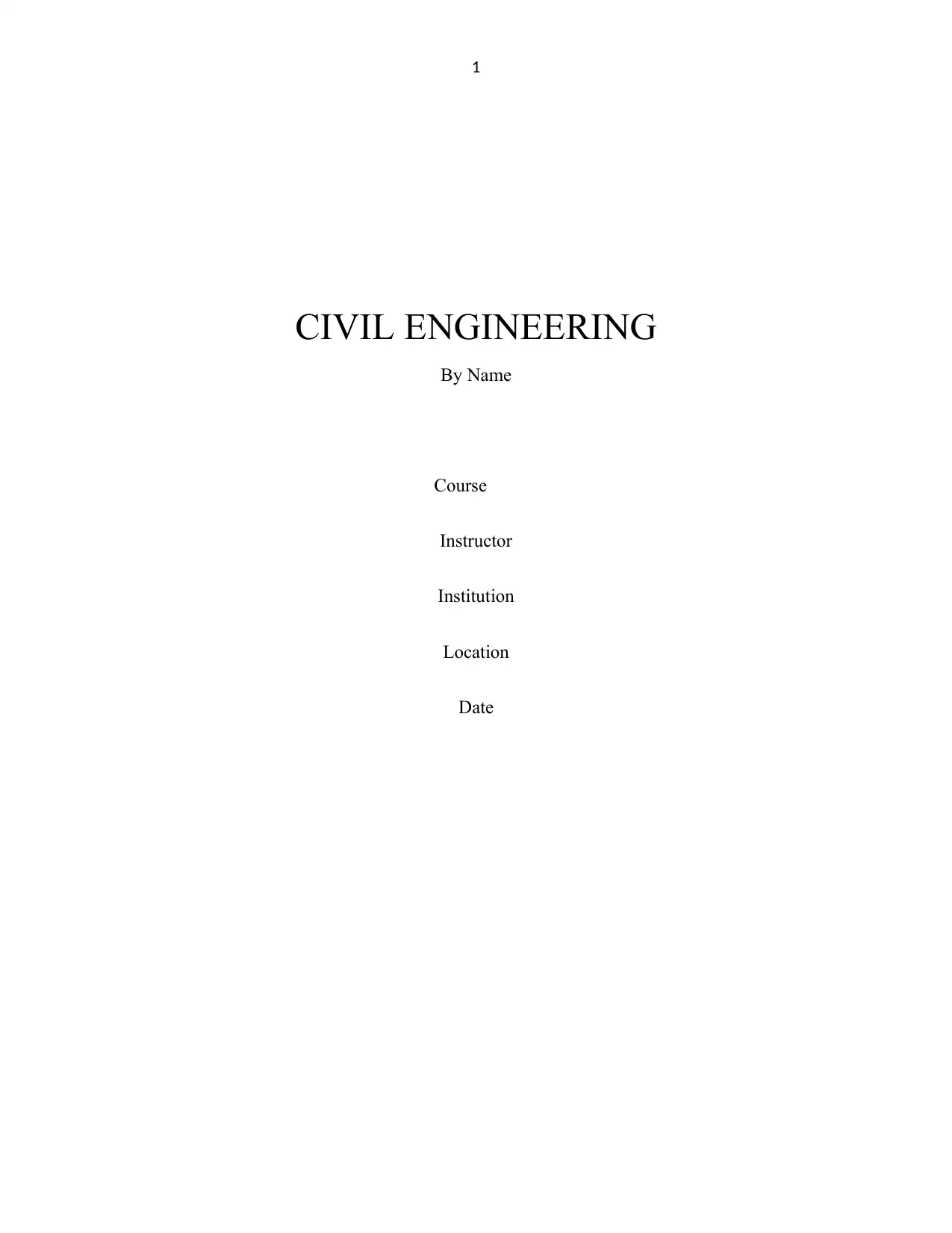
1
CIVIL ENGINEERING
By Name
Course
Instructor
Institution
Location
Date
CIVIL ENGINEERING
By Name
Course
Instructor
Institution
Location
Date
Paraphrase This Document
Need a fresh take? Get an instant paraphrase of this document with our AI Paraphraser
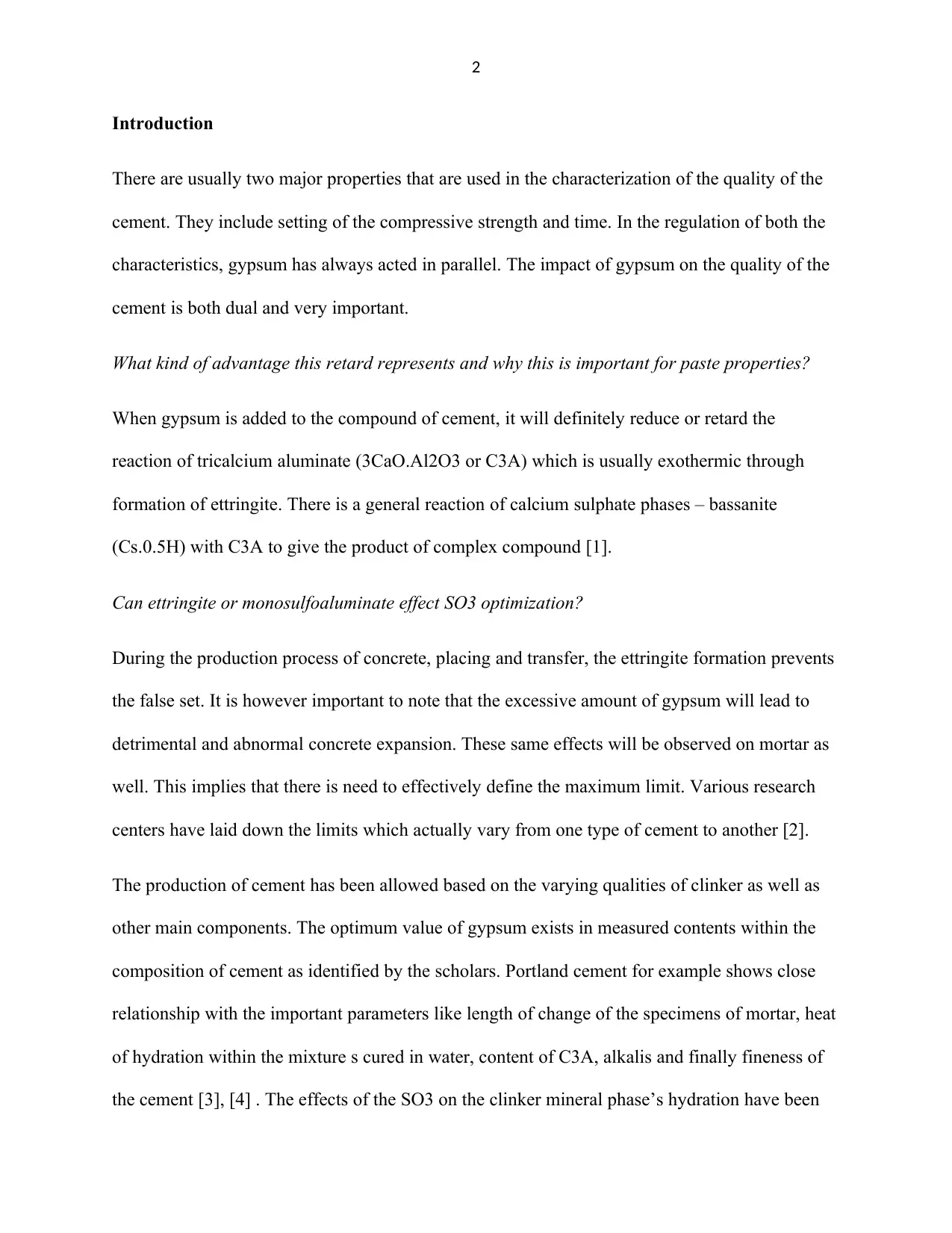
2
Introduction
There are usually two major properties that are used in the characterization of the quality of the
cement. They include setting of the compressive strength and time. In the regulation of both the
characteristics, gypsum has always acted in parallel. The impact of gypsum on the quality of the
cement is both dual and very important.
What kind of advantage this retard represents and why this is important for paste properties?
When gypsum is added to the compound of cement, it will definitely reduce or retard the
reaction of tricalcium aluminate (3CaO.Al2O3 or C3A) which is usually exothermic through
formation of ettringite. There is a general reaction of calcium sulphate phases – bassanite
(Cs.0.5H) with C3A to give the product of complex compound [1].
Can ettringite or monosulfoaluminate effect SO3 optimization?
During the production process of concrete, placing and transfer, the ettringite formation prevents
the false set. It is however important to note that the excessive amount of gypsum will lead to
detrimental and abnormal concrete expansion. These same effects will be observed on mortar as
well. This implies that there is need to effectively define the maximum limit. Various research
centers have laid down the limits which actually vary from one type of cement to another [2].
The production of cement has been allowed based on the varying qualities of clinker as well as
other main components. The optimum value of gypsum exists in measured contents within the
composition of cement as identified by the scholars. Portland cement for example shows close
relationship with the important parameters like length of change of the specimens of mortar, heat
of hydration within the mixture s cured in water, content of C3A, alkalis and finally fineness of
the cement [3], [4] . The effects of the SO3 on the clinker mineral phase’s hydration have been
Introduction
There are usually two major properties that are used in the characterization of the quality of the
cement. They include setting of the compressive strength and time. In the regulation of both the
characteristics, gypsum has always acted in parallel. The impact of gypsum on the quality of the
cement is both dual and very important.
What kind of advantage this retard represents and why this is important for paste properties?
When gypsum is added to the compound of cement, it will definitely reduce or retard the
reaction of tricalcium aluminate (3CaO.Al2O3 or C3A) which is usually exothermic through
formation of ettringite. There is a general reaction of calcium sulphate phases – bassanite
(Cs.0.5H) with C3A to give the product of complex compound [1].
Can ettringite or monosulfoaluminate effect SO3 optimization?
During the production process of concrete, placing and transfer, the ettringite formation prevents
the false set. It is however important to note that the excessive amount of gypsum will lead to
detrimental and abnormal concrete expansion. These same effects will be observed on mortar as
well. This implies that there is need to effectively define the maximum limit. Various research
centers have laid down the limits which actually vary from one type of cement to another [2].
The production of cement has been allowed based on the varying qualities of clinker as well as
other main components. The optimum value of gypsum exists in measured contents within the
composition of cement as identified by the scholars. Portland cement for example shows close
relationship with the important parameters like length of change of the specimens of mortar, heat
of hydration within the mixture s cured in water, content of C3A, alkalis and finally fineness of
the cement [3], [4] . The effects of the SO3 on the clinker mineral phase’s hydration have been
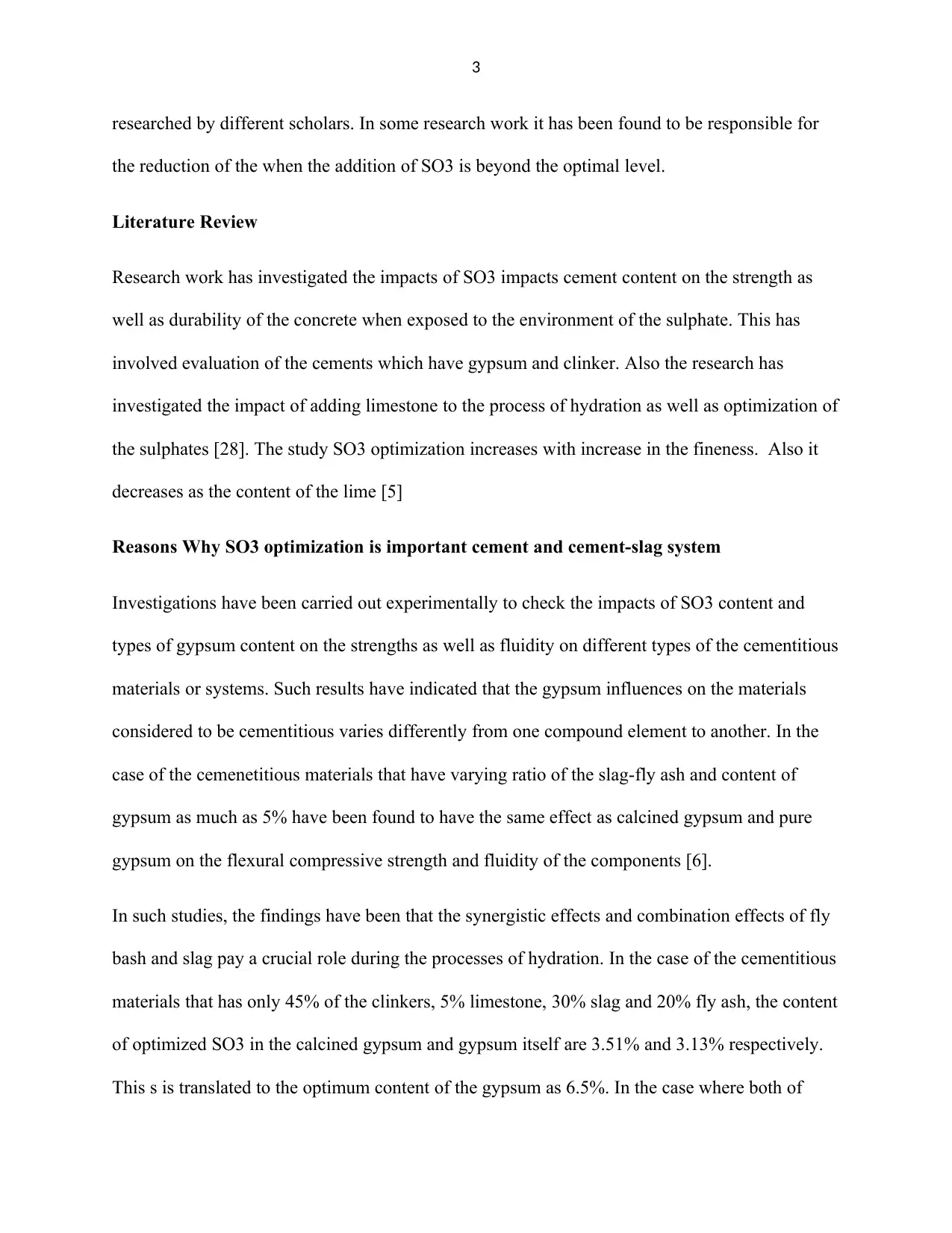
3
researched by different scholars. In some research work it has been found to be responsible for
the reduction of the when the addition of SO3 is beyond the optimal level.
Literature Review
Research work has investigated the impacts of SO3 impacts cement content on the strength as
well as durability of the concrete when exposed to the environment of the sulphate. This has
involved evaluation of the cements which have gypsum and clinker. Also the research has
investigated the impact of adding limestone to the process of hydration as well as optimization of
the sulphates [28]. The study SO3 optimization increases with increase in the fineness. Also it
decreases as the content of the lime [5]
Reasons Why SO3 optimization is important cement and cement-slag system
Investigations have been carried out experimentally to check the impacts of SO3 content and
types of gypsum content on the strengths as well as fluidity on different types of the cementitious
materials or systems. Such results have indicated that the gypsum influences on the materials
considered to be cementitious varies differently from one compound element to another. In the
case of the cemenetitious materials that have varying ratio of the slag-fly ash and content of
gypsum as much as 5% have been found to have the same effect as calcined gypsum and pure
gypsum on the flexural compressive strength and fluidity of the components [6].
In such studies, the findings have been that the synergistic effects and combination effects of fly
bash and slag pay a crucial role during the processes of hydration. In the case of the cementitious
materials that has only 45% of the clinkers, 5% limestone, 30% slag and 20% fly ash, the content
of optimized SO3 in the calcined gypsum and gypsum itself are 3.51% and 3.13% respectively.
This s is translated to the optimum content of the gypsum as 6.5%. In the case where both of
researched by different scholars. In some research work it has been found to be responsible for
the reduction of the when the addition of SO3 is beyond the optimal level.
Literature Review
Research work has investigated the impacts of SO3 impacts cement content on the strength as
well as durability of the concrete when exposed to the environment of the sulphate. This has
involved evaluation of the cements which have gypsum and clinker. Also the research has
investigated the impact of adding limestone to the process of hydration as well as optimization of
the sulphates [28]. The study SO3 optimization increases with increase in the fineness. Also it
decreases as the content of the lime [5]
Reasons Why SO3 optimization is important cement and cement-slag system
Investigations have been carried out experimentally to check the impacts of SO3 content and
types of gypsum content on the strengths as well as fluidity on different types of the cementitious
materials or systems. Such results have indicated that the gypsum influences on the materials
considered to be cementitious varies differently from one compound element to another. In the
case of the cemenetitious materials that have varying ratio of the slag-fly ash and content of
gypsum as much as 5% have been found to have the same effect as calcined gypsum and pure
gypsum on the flexural compressive strength and fluidity of the components [6].
In such studies, the findings have been that the synergistic effects and combination effects of fly
bash and slag pay a crucial role during the processes of hydration. In the case of the cementitious
materials that has only 45% of the clinkers, 5% limestone, 30% slag and 20% fly ash, the content
of optimized SO3 in the calcined gypsum and gypsum itself are 3.51% and 3.13% respectively.
This s is translated to the optimum content of the gypsum as 6.5%. In the case where both of
⊘ This is a preview!⊘
Do you want full access?
Subscribe today to unlock all pages.

Trusted by 1+ million students worldwide
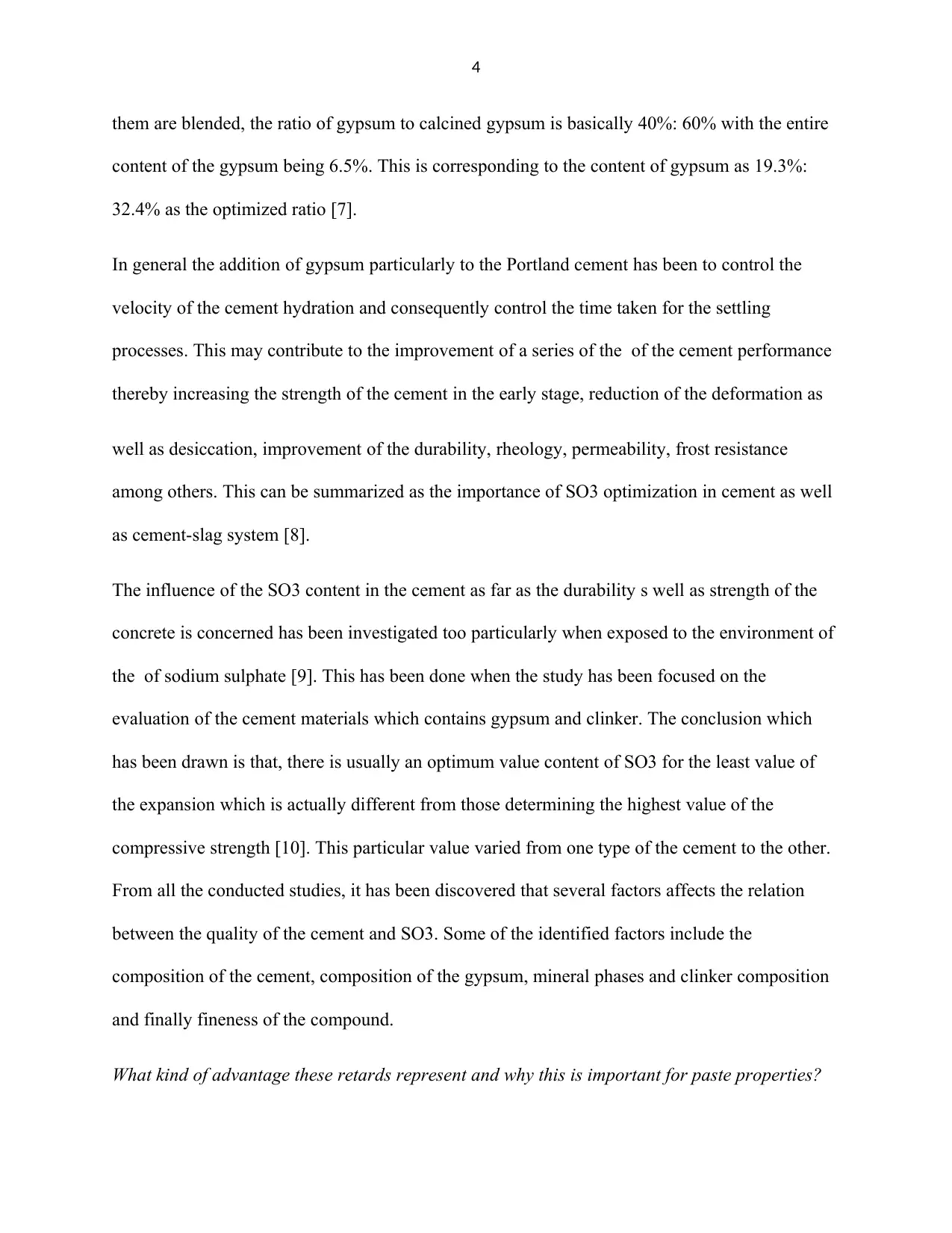
4
them are blended, the ratio of gypsum to calcined gypsum is basically 40%: 60% with the entire
content of the gypsum being 6.5%. This is corresponding to the content of gypsum as 19.3%:
32.4% as the optimized ratio [7].
In general the addition of gypsum particularly to the Portland cement has been to control the
velocity of the cement hydration and consequently control the time taken for the settling
processes. This may contribute to the improvement of a series of the of the cement performance
thereby increasing the strength of the cement in the early stage, reduction of the deformation as
well as desiccation, improvement of the durability, rheology, permeability, frost resistance
among others. This can be summarized as the importance of SO3 optimization in cement as well
as cement-slag system [8].
The influence of the SO3 content in the cement as far as the durability s well as strength of the
concrete is concerned has been investigated too particularly when exposed to the environment of
the of sodium sulphate [9]. This has been done when the study has been focused on the
evaluation of the cement materials which contains gypsum and clinker. The conclusion which
has been drawn is that, there is usually an optimum value content of SO3 for the least value of
the expansion which is actually different from those determining the highest value of the
compressive strength [10]. This particular value varied from one type of the cement to the other.
From all the conducted studies, it has been discovered that several factors affects the relation
between the quality of the cement and SO3. Some of the identified factors include the
composition of the cement, composition of the gypsum, mineral phases and clinker composition
and finally fineness of the compound.
What kind of advantage these retards represent and why this is important for paste properties?
them are blended, the ratio of gypsum to calcined gypsum is basically 40%: 60% with the entire
content of the gypsum being 6.5%. This is corresponding to the content of gypsum as 19.3%:
32.4% as the optimized ratio [7].
In general the addition of gypsum particularly to the Portland cement has been to control the
velocity of the cement hydration and consequently control the time taken for the settling
processes. This may contribute to the improvement of a series of the of the cement performance
thereby increasing the strength of the cement in the early stage, reduction of the deformation as
well as desiccation, improvement of the durability, rheology, permeability, frost resistance
among others. This can be summarized as the importance of SO3 optimization in cement as well
as cement-slag system [8].
The influence of the SO3 content in the cement as far as the durability s well as strength of the
concrete is concerned has been investigated too particularly when exposed to the environment of
the of sodium sulphate [9]. This has been done when the study has been focused on the
evaluation of the cement materials which contains gypsum and clinker. The conclusion which
has been drawn is that, there is usually an optimum value content of SO3 for the least value of
the expansion which is actually different from those determining the highest value of the
compressive strength [10]. This particular value varied from one type of the cement to the other.
From all the conducted studies, it has been discovered that several factors affects the relation
between the quality of the cement and SO3. Some of the identified factors include the
composition of the cement, composition of the gypsum, mineral phases and clinker composition
and finally fineness of the compound.
What kind of advantage these retards represent and why this is important for paste properties?
Paraphrase This Document
Need a fresh take? Get an instant paraphrase of this document with our AI Paraphraser
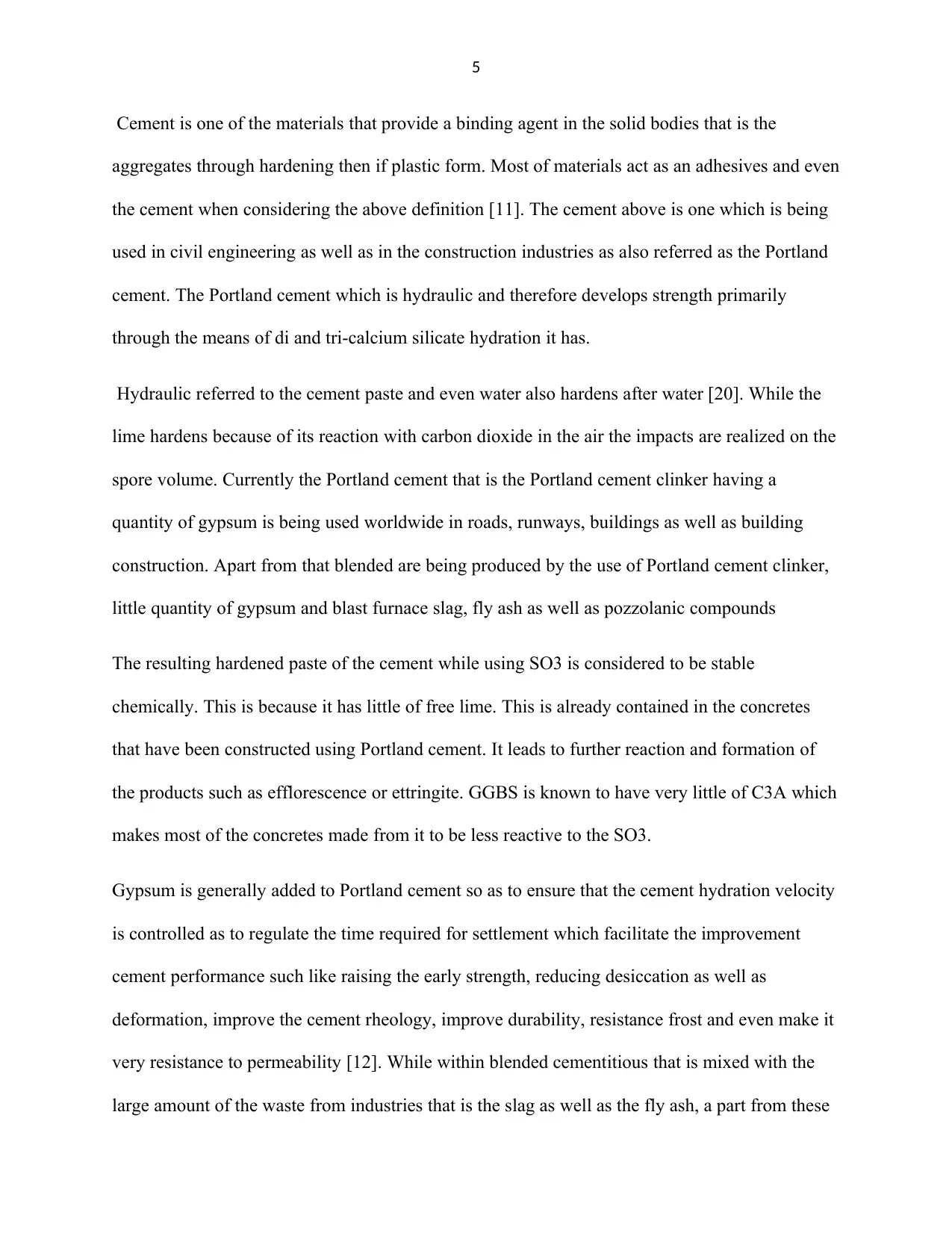
5
Cement is one of the materials that provide a binding agent in the solid bodies that is the
aggregates through hardening then if plastic form. Most of materials act as an adhesives and even
the cement when considering the above definition [11]. The cement above is one which is being
used in civil engineering as well as in the construction industries as also referred as the Portland
cement. The Portland cement which is hydraulic and therefore develops strength primarily
through the means of di and tri-calcium silicate hydration it has.
Hydraulic referred to the cement paste and even water also hardens after water [20]. While the
lime hardens because of its reaction with carbon dioxide in the air the impacts are realized on the
spore volume. Currently the Portland cement that is the Portland cement clinker having a
quantity of gypsum is being used worldwide in roads, runways, buildings as well as building
construction. Apart from that blended are being produced by the use of Portland cement clinker,
little quantity of gypsum and blast furnace slag, fly ash as well as pozzolanic compounds
The resulting hardened paste of the cement while using SO3 is considered to be stable
chemically. This is because it has little of free lime. This is already contained in the concretes
that have been constructed using Portland cement. It leads to further reaction and formation of
the products such as efflorescence or ettringite. GGBS is known to have very little of C3A which
makes most of the concretes made from it to be less reactive to the SO3.
Gypsum is generally added to Portland cement so as to ensure that the cement hydration velocity
is controlled as to regulate the time required for settlement which facilitate the improvement
cement performance such like raising the early strength, reducing desiccation as well as
deformation, improve the cement rheology, improve durability, resistance frost and even make it
very resistance to permeability [12]. While within blended cementitious that is mixed with the
large amount of the waste from industries that is the slag as well as the fly ash, a part from these
Cement is one of the materials that provide a binding agent in the solid bodies that is the
aggregates through hardening then if plastic form. Most of materials act as an adhesives and even
the cement when considering the above definition [11]. The cement above is one which is being
used in civil engineering as well as in the construction industries as also referred as the Portland
cement. The Portland cement which is hydraulic and therefore develops strength primarily
through the means of di and tri-calcium silicate hydration it has.
Hydraulic referred to the cement paste and even water also hardens after water [20]. While the
lime hardens because of its reaction with carbon dioxide in the air the impacts are realized on the
spore volume. Currently the Portland cement that is the Portland cement clinker having a
quantity of gypsum is being used worldwide in roads, runways, buildings as well as building
construction. Apart from that blended are being produced by the use of Portland cement clinker,
little quantity of gypsum and blast furnace slag, fly ash as well as pozzolanic compounds
The resulting hardened paste of the cement while using SO3 is considered to be stable
chemically. This is because it has little of free lime. This is already contained in the concretes
that have been constructed using Portland cement. It leads to further reaction and formation of
the products such as efflorescence or ettringite. GGBS is known to have very little of C3A which
makes most of the concretes made from it to be less reactive to the SO3.
Gypsum is generally added to Portland cement so as to ensure that the cement hydration velocity
is controlled as to regulate the time required for settlement which facilitate the improvement
cement performance such like raising the early strength, reducing desiccation as well as
deformation, improve the cement rheology, improve durability, resistance frost and even make it
very resistance to permeability [12]. While within blended cementitious that is mixed with the
large amount of the waste from industries that is the slag as well as the fly ash, a part from these
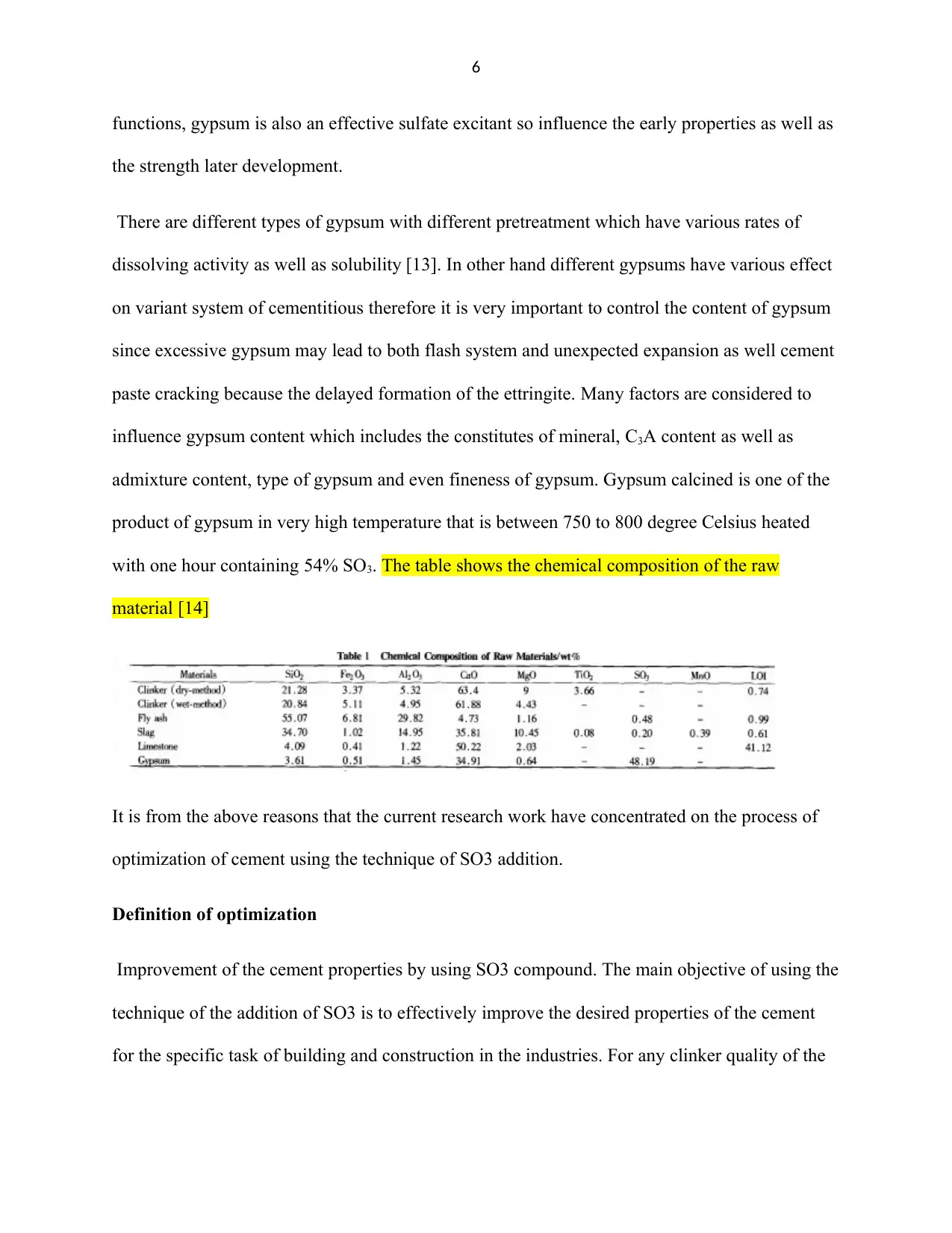
6
functions, gypsum is also an effective sulfate excitant so influence the early properties as well as
the strength later development.
There are different types of gypsum with different pretreatment which have various rates of
dissolving activity as well as solubility [13]. In other hand different gypsums have various effect
on variant system of cementitious therefore it is very important to control the content of gypsum
since excessive gypsum may lead to both flash system and unexpected expansion as well cement
paste cracking because the delayed formation of the ettringite. Many factors are considered to
influence gypsum content which includes the constitutes of mineral, C3A content as well as
admixture content, type of gypsum and even fineness of gypsum. Gypsum calcined is one of the
product of gypsum in very high temperature that is between 750 to 800 degree Celsius heated
with one hour containing 54% SO3. The table shows the chemical composition of the raw
material [14]
It is from the above reasons that the current research work have concentrated on the process of
optimization of cement using the technique of SO3 addition.
Definition of optimization
Improvement of the cement properties by using SO3 compound. The main objective of using the
technique of the addition of SO3 is to effectively improve the desired properties of the cement
for the specific task of building and construction in the industries. For any clinker quality of the
functions, gypsum is also an effective sulfate excitant so influence the early properties as well as
the strength later development.
There are different types of gypsum with different pretreatment which have various rates of
dissolving activity as well as solubility [13]. In other hand different gypsums have various effect
on variant system of cementitious therefore it is very important to control the content of gypsum
since excessive gypsum may lead to both flash system and unexpected expansion as well cement
paste cracking because the delayed formation of the ettringite. Many factors are considered to
influence gypsum content which includes the constitutes of mineral, C3A content as well as
admixture content, type of gypsum and even fineness of gypsum. Gypsum calcined is one of the
product of gypsum in very high temperature that is between 750 to 800 degree Celsius heated
with one hour containing 54% SO3. The table shows the chemical composition of the raw
material [14]
It is from the above reasons that the current research work have concentrated on the process of
optimization of cement using the technique of SO3 addition.
Definition of optimization
Improvement of the cement properties by using SO3 compound. The main objective of using the
technique of the addition of SO3 is to effectively improve the desired properties of the cement
for the specific task of building and construction in the industries. For any clinker quality of the
⊘ This is a preview!⊘
Do you want full access?
Subscribe today to unlock all pages.

Trusted by 1+ million students worldwide
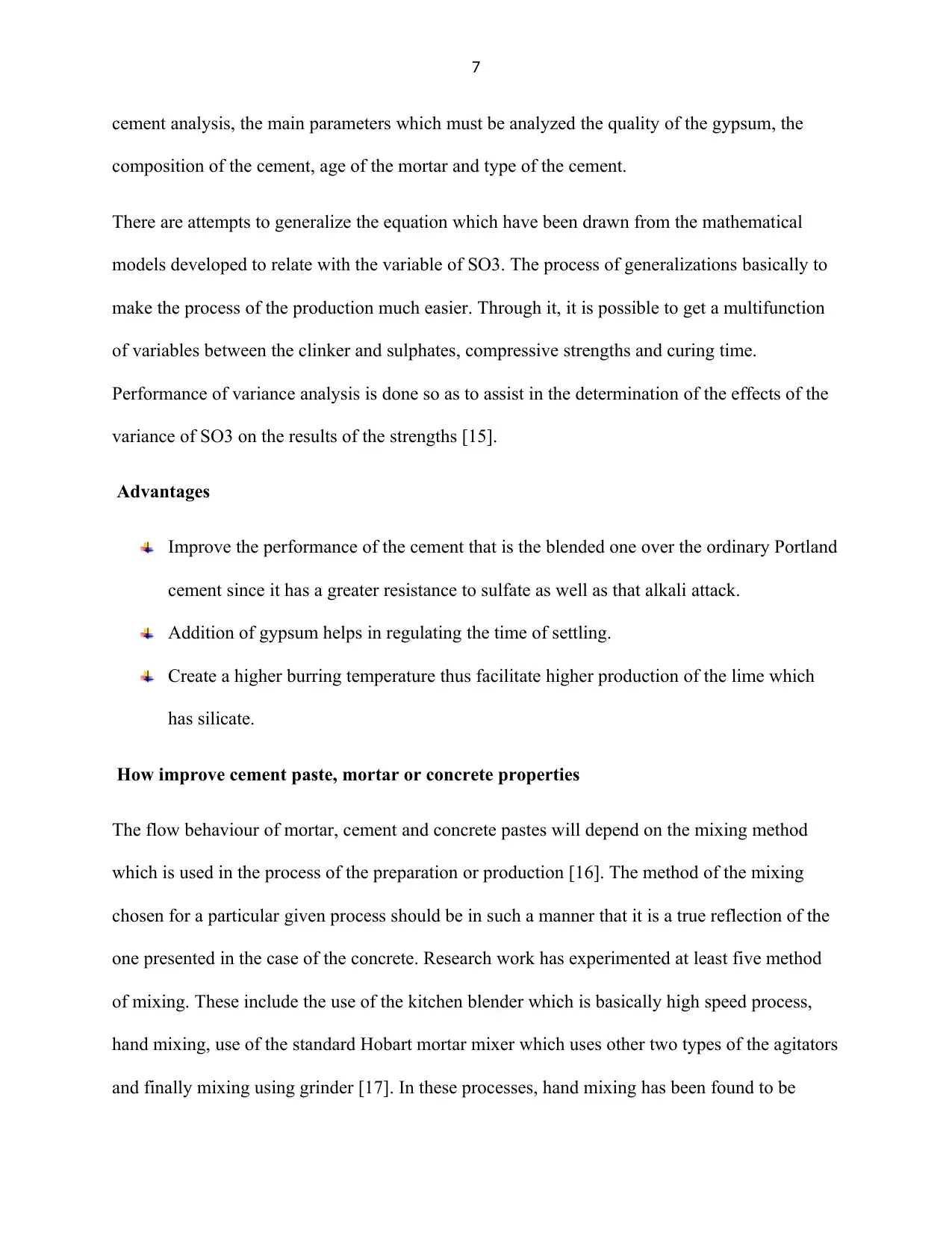
7
cement analysis, the main parameters which must be analyzed the quality of the gypsum, the
composition of the cement, age of the mortar and type of the cement.
There are attempts to generalize the equation which have been drawn from the mathematical
models developed to relate with the variable of SO3. The process of generalizations basically to
make the process of the production much easier. Through it, it is possible to get a multifunction
of variables between the clinker and sulphates, compressive strengths and curing time.
Performance of variance analysis is done so as to assist in the determination of the effects of the
variance of SO3 on the results of the strengths [15].
Advantages
Improve the performance of the cement that is the blended one over the ordinary Portland
cement since it has a greater resistance to sulfate as well as that alkali attack.
Addition of gypsum helps in regulating the time of settling.
Create a higher burring temperature thus facilitate higher production of the lime which
has silicate.
How improve cement paste, mortar or concrete properties
The flow behaviour of mortar, cement and concrete pastes will depend on the mixing method
which is used in the process of the preparation or production [16]. The method of the mixing
chosen for a particular given process should be in such a manner that it is a true reflection of the
one presented in the case of the concrete. Research work has experimented at least five method
of mixing. These include the use of the kitchen blender which is basically high speed process,
hand mixing, use of the standard Hobart mortar mixer which uses other two types of the agitators
and finally mixing using grinder [17]. In these processes, hand mixing has been found to be
cement analysis, the main parameters which must be analyzed the quality of the gypsum, the
composition of the cement, age of the mortar and type of the cement.
There are attempts to generalize the equation which have been drawn from the mathematical
models developed to relate with the variable of SO3. The process of generalizations basically to
make the process of the production much easier. Through it, it is possible to get a multifunction
of variables between the clinker and sulphates, compressive strengths and curing time.
Performance of variance analysis is done so as to assist in the determination of the effects of the
variance of SO3 on the results of the strengths [15].
Advantages
Improve the performance of the cement that is the blended one over the ordinary Portland
cement since it has a greater resistance to sulfate as well as that alkali attack.
Addition of gypsum helps in regulating the time of settling.
Create a higher burring temperature thus facilitate higher production of the lime which
has silicate.
How improve cement paste, mortar or concrete properties
The flow behaviour of mortar, cement and concrete pastes will depend on the mixing method
which is used in the process of the preparation or production [16]. The method of the mixing
chosen for a particular given process should be in such a manner that it is a true reflection of the
one presented in the case of the concrete. Research work has experimented at least five method
of mixing. These include the use of the kitchen blender which is basically high speed process,
hand mixing, use of the standard Hobart mortar mixer which uses other two types of the agitators
and finally mixing using grinder [17]. In these processes, hand mixing has been found to be
Paraphrase This Document
Need a fresh take? Get an instant paraphrase of this document with our AI Paraphraser
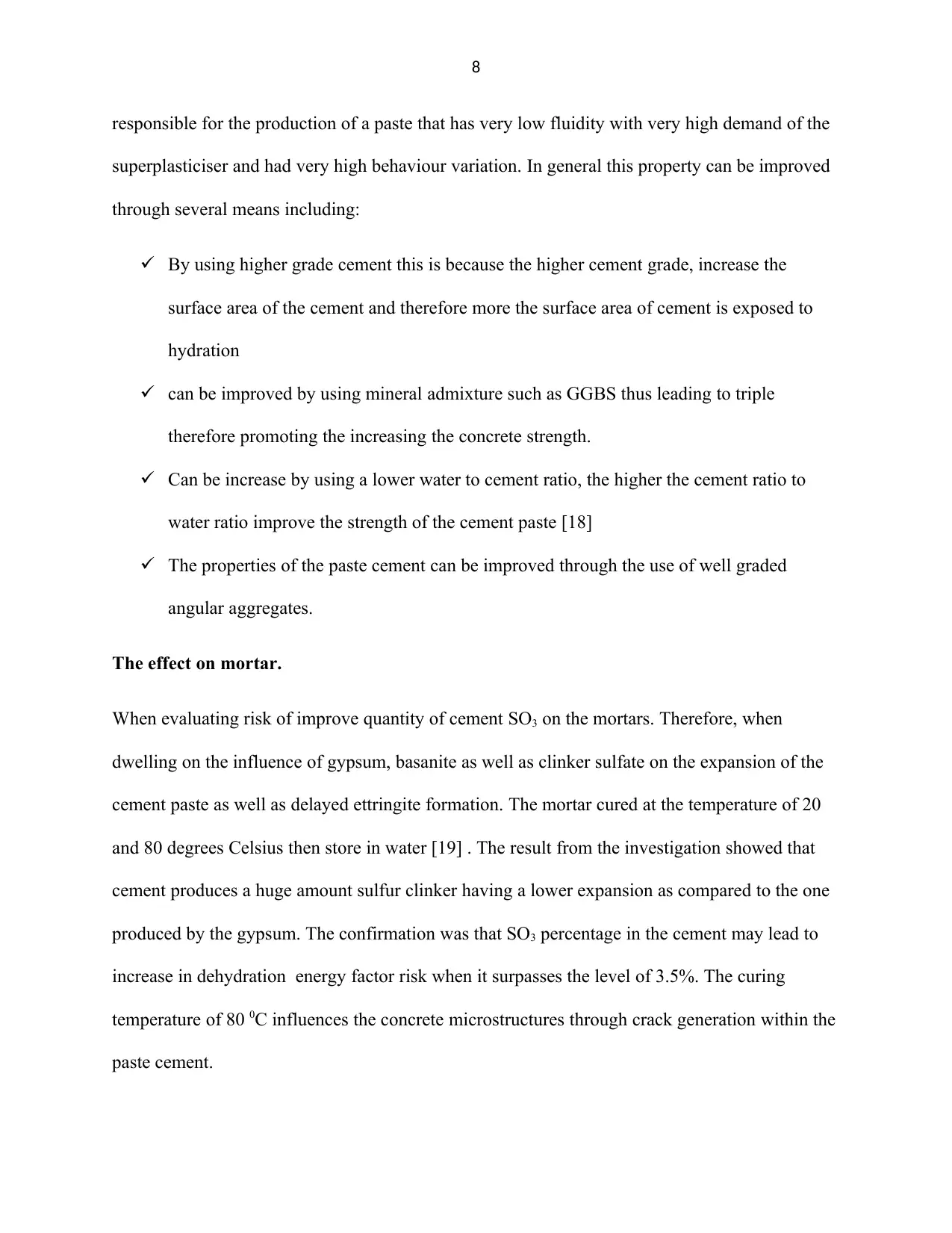
8
responsible for the production of a paste that has very low fluidity with very high demand of the
superplasticiser and had very high behaviour variation. In general this property can be improved
through several means including:
By using higher grade cement this is because the higher cement grade, increase the
surface area of the cement and therefore more the surface area of cement is exposed to
hydration
can be improved by using mineral admixture such as GGBS thus leading to triple
therefore promoting the increasing the concrete strength.
Can be increase by using a lower water to cement ratio, the higher the cement ratio to
water ratio improve the strength of the cement paste [18]
The properties of the paste cement can be improved through the use of well graded
angular aggregates.
The effect on mortar.
When evaluating risk of improve quantity of cement SO3 on the mortars. Therefore, when
dwelling on the influence of gypsum, basanite as well as clinker sulfate on the expansion of the
cement paste as well as delayed ettringite formation. The mortar cured at the temperature of 20
and 80 degrees Celsius then store in water [19] . The result from the investigation showed that
cement produces a huge amount sulfur clinker having a lower expansion as compared to the one
produced by the gypsum. The confirmation was that SO3 percentage in the cement may lead to
increase in dehydration energy factor risk when it surpasses the level of 3.5%. The curing
temperature of 80 0C influences the concrete microstructures through crack generation within the
paste cement.
responsible for the production of a paste that has very low fluidity with very high demand of the
superplasticiser and had very high behaviour variation. In general this property can be improved
through several means including:
By using higher grade cement this is because the higher cement grade, increase the
surface area of the cement and therefore more the surface area of cement is exposed to
hydration
can be improved by using mineral admixture such as GGBS thus leading to triple
therefore promoting the increasing the concrete strength.
Can be increase by using a lower water to cement ratio, the higher the cement ratio to
water ratio improve the strength of the cement paste [18]
The properties of the paste cement can be improved through the use of well graded
angular aggregates.
The effect on mortar.
When evaluating risk of improve quantity of cement SO3 on the mortars. Therefore, when
dwelling on the influence of gypsum, basanite as well as clinker sulfate on the expansion of the
cement paste as well as delayed ettringite formation. The mortar cured at the temperature of 20
and 80 degrees Celsius then store in water [19] . The result from the investigation showed that
cement produces a huge amount sulfur clinker having a lower expansion as compared to the one
produced by the gypsum. The confirmation was that SO3 percentage in the cement may lead to
increase in dehydration energy factor risk when it surpasses the level of 3.5%. The curing
temperature of 80 0C influences the concrete microstructures through crack generation within the
paste cement.
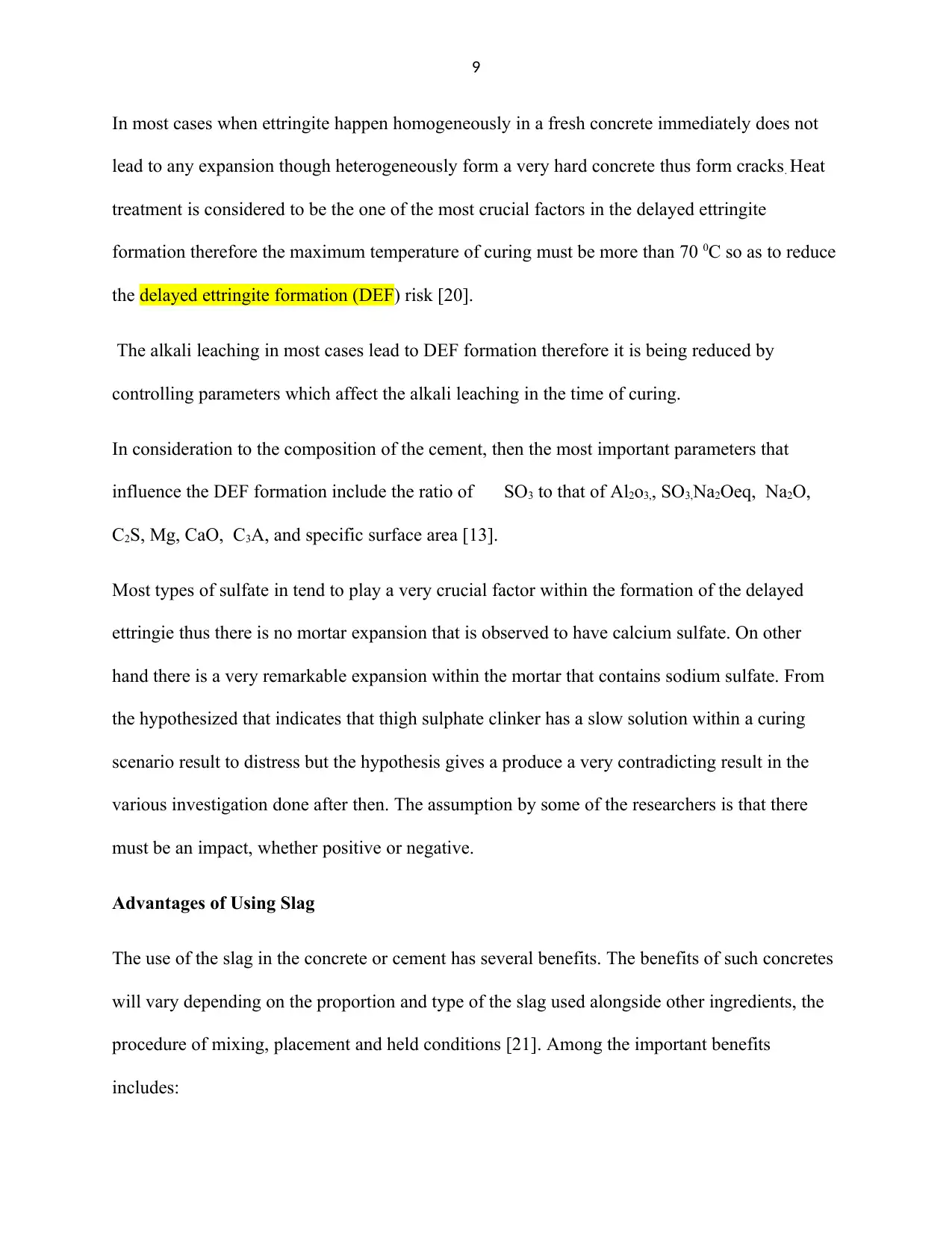
9
In most cases when ettringite happen homogeneously in a fresh concrete immediately does not
lead to any expansion though heterogeneously form a very hard concrete thus form cracks. Heat
treatment is considered to be the one of the most crucial factors in the delayed ettringite
formation therefore the maximum temperature of curing must be more than 70 0C so as to reduce
the delayed ettringite formation (DEF) risk [20].
The alkali leaching in most cases lead to DEF formation therefore it is being reduced by
controlling parameters which affect the alkali leaching in the time of curing.
In consideration to the composition of the cement, then the most important parameters that
influence the DEF formation include the ratio of SO3 to that of Al2o3,, SO3,Na2Oeq, Na2O,
C2S, Mg, CaO, C3A, and specific surface area [13].
Most types of sulfate in tend to play a very crucial factor within the formation of the delayed
ettringie thus there is no mortar expansion that is observed to have calcium sulfate. On other
hand there is a very remarkable expansion within the mortar that contains sodium sulfate. From
the hypothesized that indicates that thigh sulphate clinker has a slow solution within a curing
scenario result to distress but the hypothesis gives a produce a very contradicting result in the
various investigation done after then. The assumption by some of the researchers is that there
must be an impact, whether positive or negative.
Advantages of Using Slag
The use of the slag in the concrete or cement has several benefits. The benefits of such concretes
will vary depending on the proportion and type of the slag used alongside other ingredients, the
procedure of mixing, placement and held conditions [21]. Among the important benefits
includes:
In most cases when ettringite happen homogeneously in a fresh concrete immediately does not
lead to any expansion though heterogeneously form a very hard concrete thus form cracks. Heat
treatment is considered to be the one of the most crucial factors in the delayed ettringite
formation therefore the maximum temperature of curing must be more than 70 0C so as to reduce
the delayed ettringite formation (DEF) risk [20].
The alkali leaching in most cases lead to DEF formation therefore it is being reduced by
controlling parameters which affect the alkali leaching in the time of curing.
In consideration to the composition of the cement, then the most important parameters that
influence the DEF formation include the ratio of SO3 to that of Al2o3,, SO3,Na2Oeq, Na2O,
C2S, Mg, CaO, C3A, and specific surface area [13].
Most types of sulfate in tend to play a very crucial factor within the formation of the delayed
ettringie thus there is no mortar expansion that is observed to have calcium sulfate. On other
hand there is a very remarkable expansion within the mortar that contains sodium sulfate. From
the hypothesized that indicates that thigh sulphate clinker has a slow solution within a curing
scenario result to distress but the hypothesis gives a produce a very contradicting result in the
various investigation done after then. The assumption by some of the researchers is that there
must be an impact, whether positive or negative.
Advantages of Using Slag
The use of the slag in the concrete or cement has several benefits. The benefits of such concretes
will vary depending on the proportion and type of the slag used alongside other ingredients, the
procedure of mixing, placement and held conditions [21]. Among the important benefits
includes:
⊘ This is a preview!⊘
Do you want full access?
Subscribe today to unlock all pages.

Trusted by 1+ million students worldwide
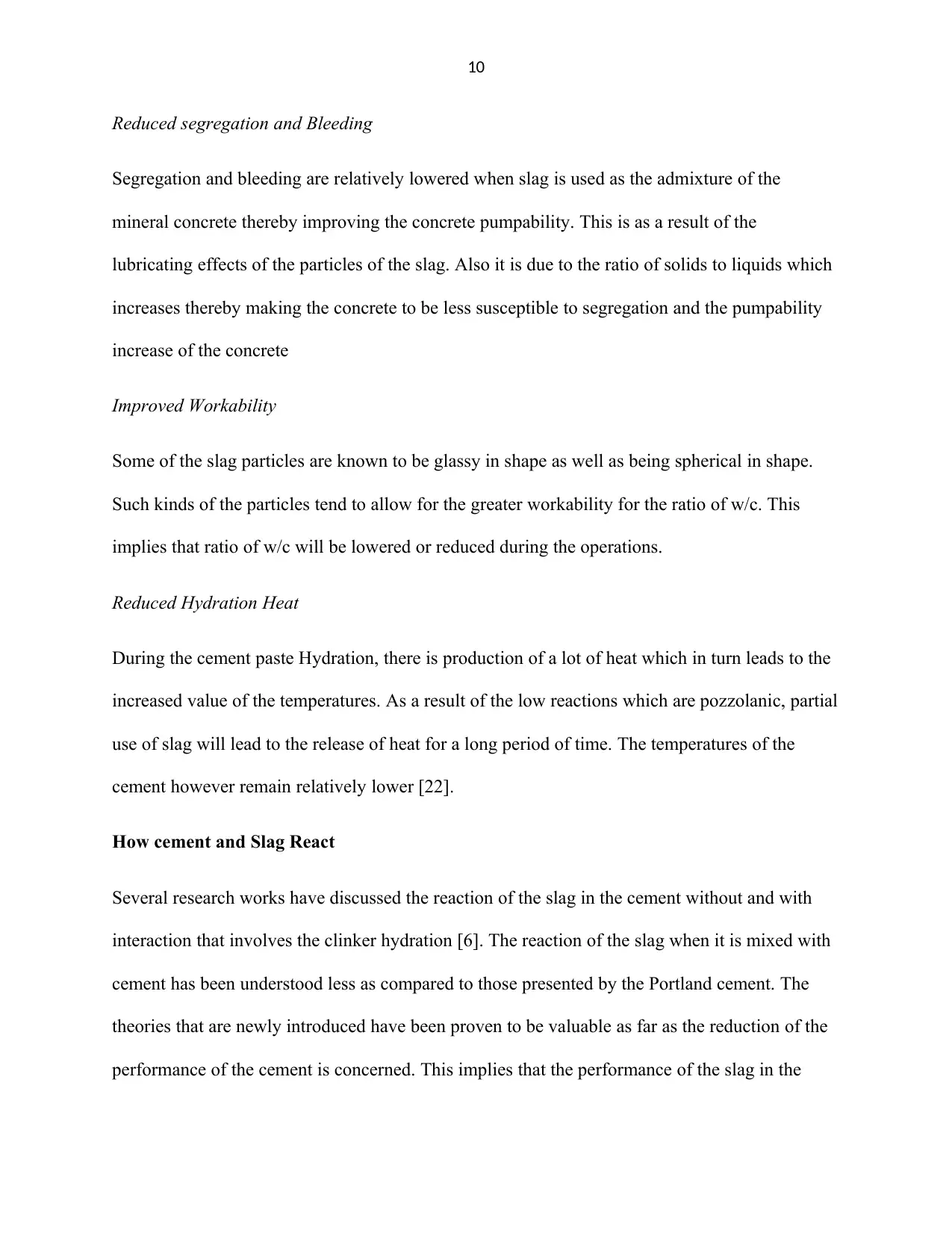
10
Reduced segregation and Bleeding
Segregation and bleeding are relatively lowered when slag is used as the admixture of the
mineral concrete thereby improving the concrete pumpability. This is as a result of the
lubricating effects of the particles of the slag. Also it is due to the ratio of solids to liquids which
increases thereby making the concrete to be less susceptible to segregation and the pumpability
increase of the concrete
Improved Workability
Some of the slag particles are known to be glassy in shape as well as being spherical in shape.
Such kinds of the particles tend to allow for the greater workability for the ratio of w/c. This
implies that ratio of w/c will be lowered or reduced during the operations.
Reduced Hydration Heat
During the cement paste Hydration, there is production of a lot of heat which in turn leads to the
increased value of the temperatures. As a result of the low reactions which are pozzolanic, partial
use of slag will lead to the release of heat for a long period of time. The temperatures of the
cement however remain relatively lower [22].
How cement and Slag React
Several research works have discussed the reaction of the slag in the cement without and with
interaction that involves the clinker hydration [6]. The reaction of the slag when it is mixed with
cement has been understood less as compared to those presented by the Portland cement. The
theories that are newly introduced have been proven to be valuable as far as the reduction of the
performance of the cement is concerned. This implies that the performance of the slag in the
Reduced segregation and Bleeding
Segregation and bleeding are relatively lowered when slag is used as the admixture of the
mineral concrete thereby improving the concrete pumpability. This is as a result of the
lubricating effects of the particles of the slag. Also it is due to the ratio of solids to liquids which
increases thereby making the concrete to be less susceptible to segregation and the pumpability
increase of the concrete
Improved Workability
Some of the slag particles are known to be glassy in shape as well as being spherical in shape.
Such kinds of the particles tend to allow for the greater workability for the ratio of w/c. This
implies that ratio of w/c will be lowered or reduced during the operations.
Reduced Hydration Heat
During the cement paste Hydration, there is production of a lot of heat which in turn leads to the
increased value of the temperatures. As a result of the low reactions which are pozzolanic, partial
use of slag will lead to the release of heat for a long period of time. The temperatures of the
cement however remain relatively lower [22].
How cement and Slag React
Several research works have discussed the reaction of the slag in the cement without and with
interaction that involves the clinker hydration [6]. The reaction of the slag when it is mixed with
cement has been understood less as compared to those presented by the Portland cement. The
theories that are newly introduced have been proven to be valuable as far as the reduction of the
performance of the cement is concerned. This implies that the performance of the slag in the
Paraphrase This Document
Need a fresh take? Get an instant paraphrase of this document with our AI Paraphraser
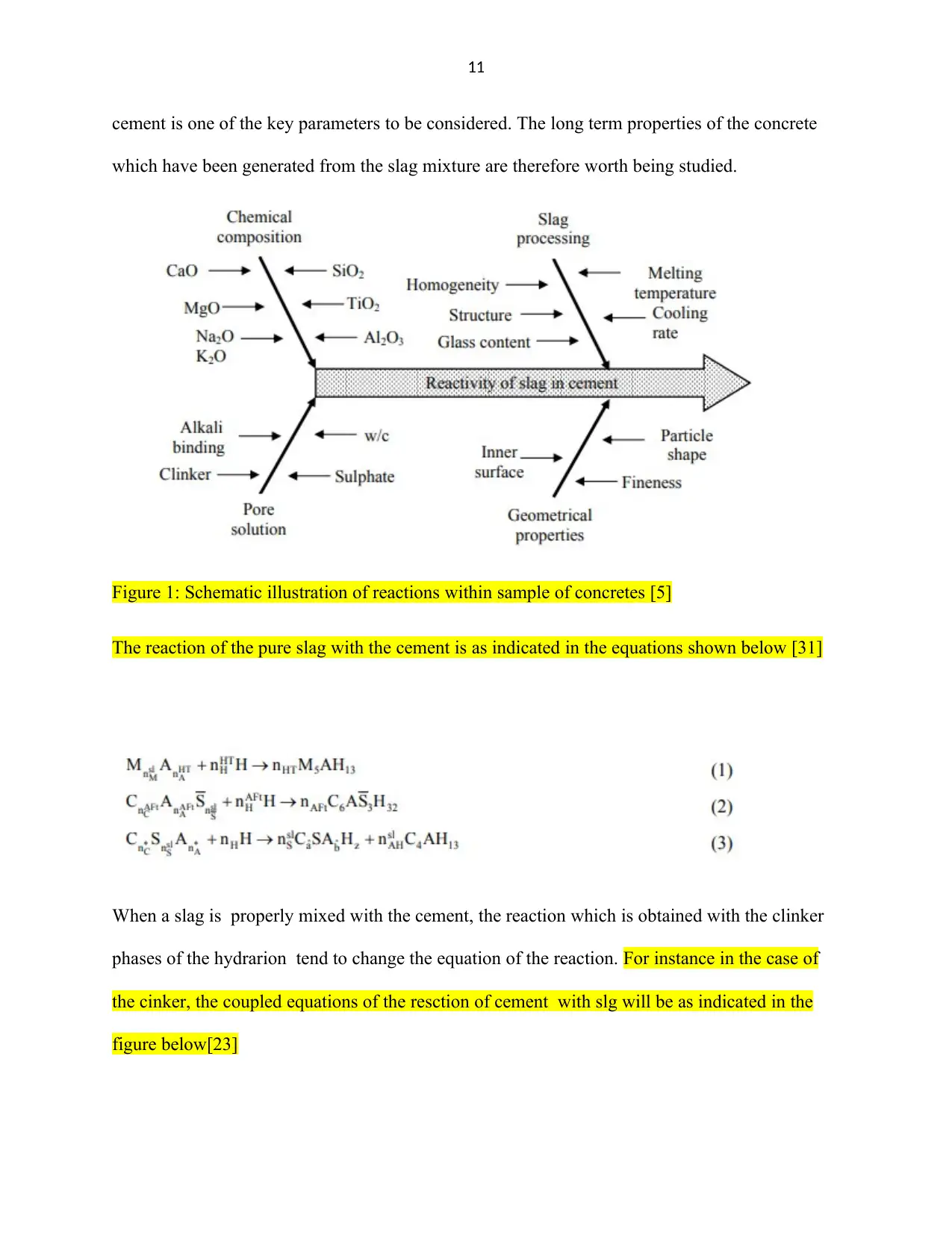
11
cement is one of the key parameters to be considered. The long term properties of the concrete
which have been generated from the slag mixture are therefore worth being studied.
Figure 1: Schematic illustration of reactions within sample of concretes [5]
The reaction of the pure slag with the cement is as indicated in the equations shown below [31]
When a slag is properly mixed with the cement, the reaction which is obtained with the clinker
phases of the hydrarion tend to change the equation of the reaction. For instance in the case of
the cinker, the coupled equations of the resction of cement with slg will be as indicated in the
figure below[23]
cement is one of the key parameters to be considered. The long term properties of the concrete
which have been generated from the slag mixture are therefore worth being studied.
Figure 1: Schematic illustration of reactions within sample of concretes [5]
The reaction of the pure slag with the cement is as indicated in the equations shown below [31]
When a slag is properly mixed with the cement, the reaction which is obtained with the clinker
phases of the hydrarion tend to change the equation of the reaction. For instance in the case of
the cinker, the coupled equations of the resction of cement with slg will be as indicated in the
figure below[23]
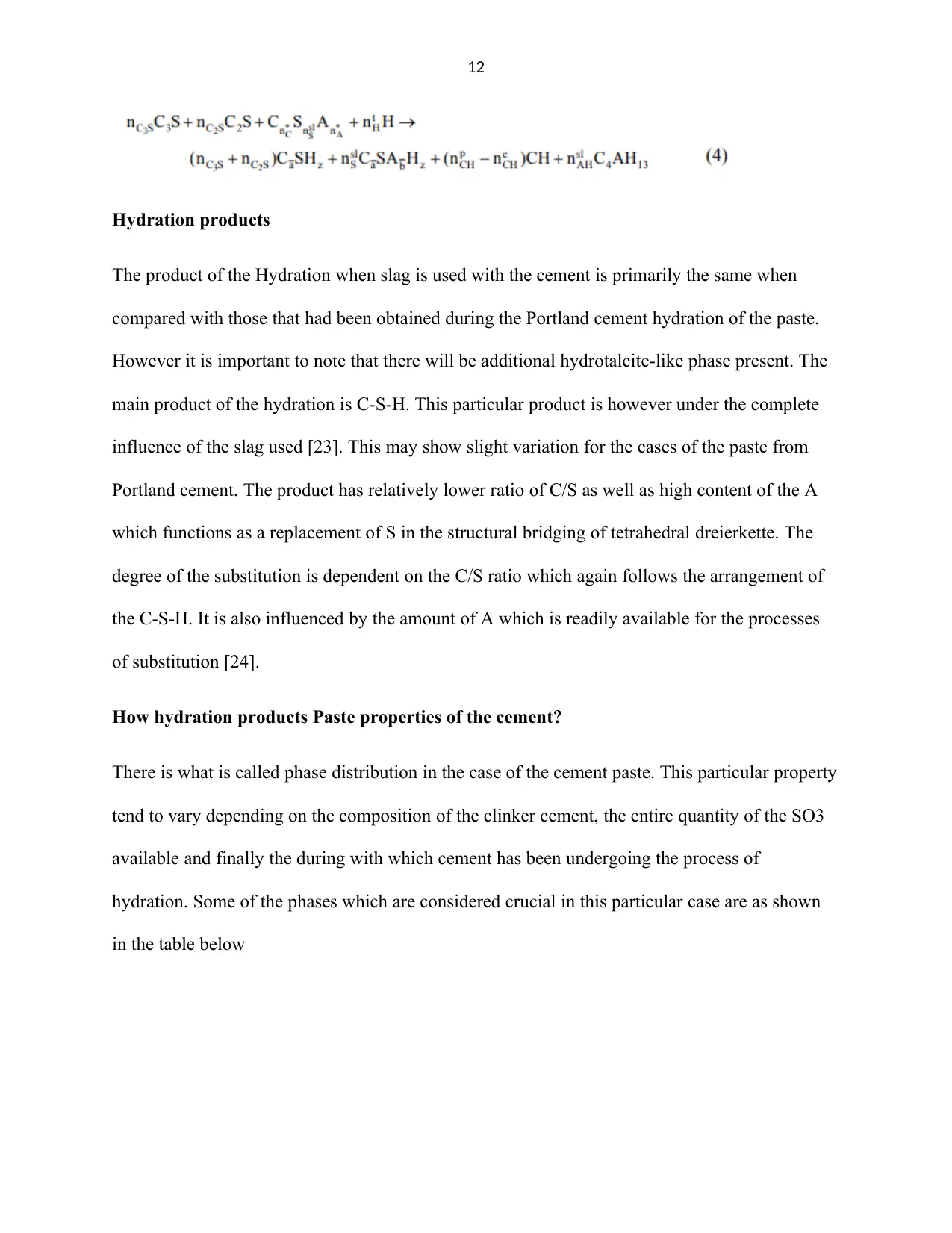
12
Hydration products
The product of the Hydration when slag is used with the cement is primarily the same when
compared with those that had been obtained during the Portland cement hydration of the paste.
However it is important to note that there will be additional hydrotalcite-like phase present. The
main product of the hydration is C-S-H. This particular product is however under the complete
influence of the slag used [23]. This may show slight variation for the cases of the paste from
Portland cement. The product has relatively lower ratio of C/S as well as high content of the A
which functions as a replacement of S in the structural bridging of tetrahedral dreierkette. The
degree of the substitution is dependent on the C/S ratio which again follows the arrangement of
the C-S-H. It is also influenced by the amount of A which is readily available for the processes
of substitution [24].
How hydration products Paste properties of the cement?
There is what is called phase distribution in the case of the cement paste. This particular property
tend to vary depending on the composition of the clinker cement, the entire quantity of the SO3
available and finally the during with which cement has been undergoing the process of
hydration. Some of the phases which are considered crucial in this particular case are as shown
in the table below
Hydration products
The product of the Hydration when slag is used with the cement is primarily the same when
compared with those that had been obtained during the Portland cement hydration of the paste.
However it is important to note that there will be additional hydrotalcite-like phase present. The
main product of the hydration is C-S-H. This particular product is however under the complete
influence of the slag used [23]. This may show slight variation for the cases of the paste from
Portland cement. The product has relatively lower ratio of C/S as well as high content of the A
which functions as a replacement of S in the structural bridging of tetrahedral dreierkette. The
degree of the substitution is dependent on the C/S ratio which again follows the arrangement of
the C-S-H. It is also influenced by the amount of A which is readily available for the processes
of substitution [24].
How hydration products Paste properties of the cement?
There is what is called phase distribution in the case of the cement paste. This particular property
tend to vary depending on the composition of the clinker cement, the entire quantity of the SO3
available and finally the during with which cement has been undergoing the process of
hydration. Some of the phases which are considered crucial in this particular case are as shown
in the table below
⊘ This is a preview!⊘
Do you want full access?
Subscribe today to unlock all pages.

Trusted by 1+ million students worldwide
1 out of 30
Your All-in-One AI-Powered Toolkit for Academic Success.
+13062052269
info@desklib.com
Available 24*7 on WhatsApp / Email
![[object Object]](/_next/static/media/star-bottom.7253800d.svg)
Unlock your academic potential
Copyright © 2020–2025 A2Z Services. All Rights Reserved. Developed and managed by ZUCOL.


